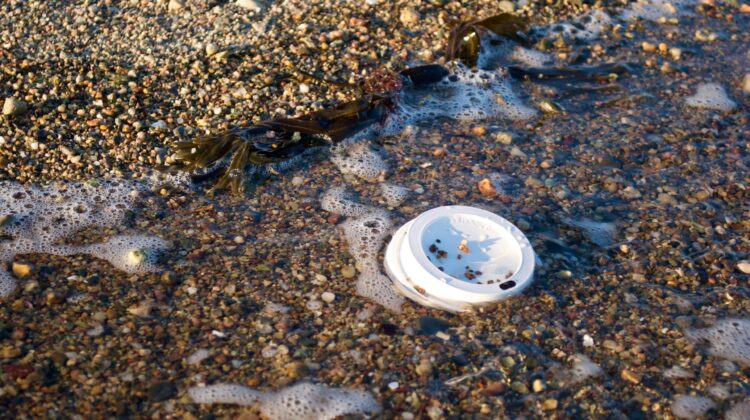
Researchers at Woods Hole Oceanographic Institution (WHOI) have developed a sustainability metric for the ecological design of plastic products that have low persistence in the environment.
‘While plastic pollution threatens ecosystems and human health, the use of plastic products continues to increase,’ the researchers wrote. ‘Limiting its harm requires design strategies for plastic products informed by the threats that plastics pose to the environment. Thus, we developed a sustainability metric for the eco-design of plastic products with low environmental persistence and uncompromised performance.’
Designing single-use plastics using this approach can have a substantial impact. Analyses in the study suggest that switching to alternative materials such as cellulose diacetate and polyhydroxyalkanoates for single-use coffee cup lids could reduce the environmental costs to society by hundreds of millions of dollars.
In general, products are designed to be environmentally friendly primarily by balancing the trade-offs between various environmental concerns, such as greenhouse gas emissions and resource depletion, because frameworks and data sets to estimate these types of impacts already exist. Selecting one kind of plastic over another is often used to accomplish this goal. However, to date, no material-selection framework has considered or quantified environmental persistence – the time that a plastic item remains in the environment as pollution – as a key environmental concern.
‘What’s important to determine is how can we design functional, sustainable and benign materials, products and processes that embody all of the principles of green-materials engineering into the future world that we are going to live in,’ said materials scientist and engineer Bryan James, a postdoctoral investigator in WHOI’s Marine Chemistry & Geochemistry Department. ‘What are the next set of strategies and tools that engineers, product designers and even the average consumer can use to make the best choices for the environment, while not having to sacrifice on product performance?’
To develop the sustainability metric, the researchers ‘integrated the environmental degradation rate of plastic into established material-selection strategies, deriving material indices for environmental persistence. Our analysis identifies the materials and their properties that deserve development, adoption and investment to create functional and less environmentally impactful plastic products,’ the study noted.
Establishing and implementing a sustainability metric for persistence has been challenging because of the lack of sufficient data for the wide range of plastics used in consumer goods. Only recently have scientists had sufficient data on realistic environmental-degradation rates of different types of plastic so that they can better consider different types of plastic properties and implement them in design.
With these data, the researchers showed that while switching one plastic material for another can reduce a product’s cost and embodied greenhouse gas emissions, that switch could provide a far greater benefit in terms of minimising environmental persistence. For example, if a product designer only considered cost and greenhouse gas emissions, polylactic acid would be a good choice. Yet, this material persists in the ocean. Comparatively, cellulose diacetate and polyhydroxyalkanoates, while currently only a bit more expensive than polylactic acid, can have lower greenhouse gas emissions and don’t persist in the ocean.
‘Ninety-nine per cent of the papers that have been published on plastic pollution tell us how bad it is. This paper is looking at the issue in a much more forward-thinking way – about how you address a problem in a meaningful scientific way that’s attainable, achievable and economically viable,’ said Christopher Reddy, a senior scientist in WHOI’s Marine Chemistry & Geochemistry Department.
As an example, the researchers applied the metric to the redesign single-use plastic coffee cup lids, billions of which are used each year, accounting for about five per cent of all plastic debris collected by coastal cleanup efforts worldwide. They evaluated which of the three currently used materials – polylactic acid, polypropylene and polystyrene – reduces the environmental impact the most.
‘Which is better: a lid that has a bit more greenhouse gas emissions but persists less in the environment or a lid that has fewer greenhouse gas emissions but will persist for a longer time? To answer this, we put a dollar value on both options in terms of cost to make the product and cost to the environment and ecosystem services,’ said James. ‘Simply making products that persist less by virtue of not being there, or going away faster, reduces that cost to society tremendously.’
‘When you are charged with making a new coffee cup lid that needs to be sustainable and green, and you have to figure out which polymer is best for the environment, currently, green might take into consideration how much energy is used to make the plastic or how much greenhouse gases are emitted. But the current calculus for a designer does not consider what the lid’s persistence is. What Bryan has done with the development of this metric is groundbreaking,’ added Reddy.
‘What’s important about this study is that it helps shift the narrative away from defining the problem of plastic pollution to arriving at solutions to the problem,’ said Collin Ward, an associate scientist in WHOI’s Marine Chemistry & Geochemistry Department. ‘Plastics are extremely useful materials – they’re not going anywhere anytime soon. But everyone agrees the amount of plastic leaking into the environment is a problem. The framework presented in this study represents an important first step towards solving this problem by designing materials that simultaneously meet the needs of consumers and do not persist if incidentally leaked into the environment.’
James noted that through thoughtful strategies to make good design decisions, ‘scientists, engineers and designers have an opportunity to make a significant impact in the plastic-pollution crisis. The metrics and methods developed in this study can direct design decisions and research priorities to reach this goal.’
The research has been published in ACS Sustainable Chemistry & Engineering.


